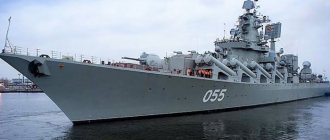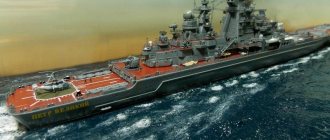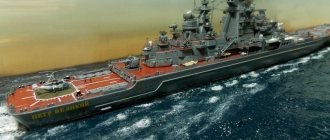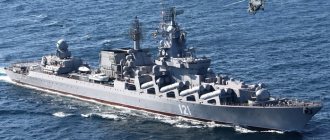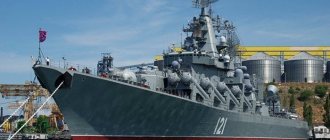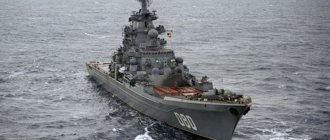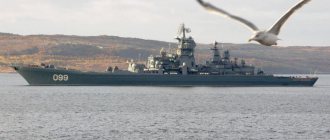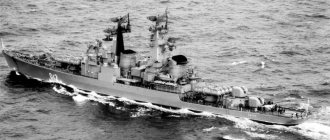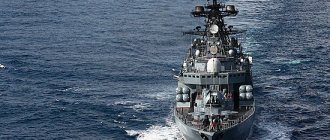09/05/2016 Category: Surface forces
- 2 History
- 3 Progress of modernization
One of the ships of the Northern Fleet, the cruiser Marshal Ustinov, is the second object built according to project 1164 Atlant. The ship was laid down and built at a construction plant in Nikolaev, launched in 1982 and included in the fleet in 1986.
Notes
- . FlotProm. Retrieved July 29, 2022.
- . FlotProm. Retrieved July 29, 2022.
- 2016-10-30 16:43:00 Zvezdochka_ru Zvezdochka_ru 2016-10-30 16:43:00 Zvezdochka_ruwrote.
(English). Retrieved July 29, 2022. - 2016-11-30 14:01:00 Zvezdochka_ru Zvezdochka_ru 2016-11-30 14:01:00 Zvezdochka_ruwrote.
(English). Retrieved July 29, 2022. - . Central Naval Portal. Retrieved July 29, 2018.
- . vpk-news.ru. Retrieved December 31, 2016.
- . RBC. Retrieved July 29, 2022.
- . Central Naval Portal. Retrieved July 29, 2018.
- . Central Naval Portal. Retrieved July 29, 2018.
- . Central Naval Portal. Retrieved July 29, 2018.
- . Central Naval Portal. Retrieved May 8, 2020.
- Northern Fleet ships returned from the Mediterranean Sea - Wikinews. ru.wikinews.org. Retrieved May 8, 2022.
- . mil.ru. Retrieved February 8, 2022.
Overall Project Assessment
In general, the Project 1164 RKRs became an alternative to the overly expensive Project 1144 Orlan cruisers.
Having a limited displacement, the Project 1164 cruisers had almost equivalent offensive weapons and comparable defensive ones. According to modern classifications, these missile cruisers correspond to missile cruisers/"large destroyers", such as Ticonderoga-class missile cruisers, Atago-class and King Sejong-class destroyers, having a similar displacement in the region of 9000-11000 tons. However, priority in the creation of Project 1164 cruisers was given to offensive rather than defensive characteristics. The ships have a reduced supply of S-300F missiles - 64, compared to 96 on the Project 1144 cruiser; The weak point is the self-defense air defense, consisting of only two outdated Osa-M air defense systems (for comparison, Project 1144 cruisers have 16 Kinzhal launchers).
In addition, due to the presence of only one 3R41 Volna missile guidance radar, the Fort anti-aircraft complex can be used to repel an attack from only one direction at a time, and if the only 3R41 Volna radar fails, the ship’s long-range air defense will be completely paralyzed. For comparison, Project 1144 cruisers have two 3R41 radars, which allows them to repel attacks from several directions simultaneously and not risk losing their defense capability if the radar fails.
In general, the ship fully complies with the “late” doctrine of the Soviet Navy - the use of surface missile carriers for strike functions, covered by carrier-based aircraft.
Background
By 1970, the surface forces of the USSR Navy consisted mainly of anti-submarine ships. The exception was the Project 58 missile cruisers. However, there were few of them, and they did not pose a significant threat to the growing US aircraft carrier fleet. To correct this situation, designers began work on a new missile cruiser that could destroy any enemy ships, and at the same time would be cheaper to build and operate than the huge nuclear-powered ships of the Orlan project.
The cruisers under development received project number 1164 and the code “Atlant”. The lead ship, Slava, was laid down in Nikolaev in 1976. The next one, Fleet Admiral Lobov, began construction in 1978. This ship will later become the “Marshal Ustinov”.
Modernization and refurbishment
From 1994 to December 17, 1997
— scheduled repairs at the St. Petersburg JSC Severnaya Verf. During the renovation, the main power plant was replaced.
From July 2011 to October 2016
the ship was undergoing repairs and modernization in (the city of Severodvinsk). During the work, new radars with phased antenna arrays were installed on the cruiser: the Podberyozovik three-dimensional early warning radar and the Fregat-M2M station, optimized for detecting low-flying targets. Also according to the plan, docking work, repairs of the main power plant and general ship systems, inspection and repair of main cables with replacement of defective sections were carried out. In total, more than 150 km of cable routes were replaced, all six gas turbine generators, a desalination plant, pitch stabilizers, shaft lines, propellers, and galley equipment were repaired and replaced; The interior of the ship was put in order. In the fall of 2016, the updated cruiser successfully completed a test program in the White Sea, after which it returned to service in the Northern Fleet.
Specifications
1st rank warship. has been undergoing major repairs and modernization since the summer of 2011, which will be completed in the fourth quarter of 2016. The Marshal Ustinov missile launcher is designed to combat AUG (carrier strike groups) in ocean waters (with a range of 7,500 miles).
- Its length is 186.5 m
- width 20.8 m
- draft 7.6 m
- Power plant power 105,000 hp.
- It develops a maximum speed of 32 knots using twin-shaft bladed propellers driven by 4 engines.
- A team of 510 food supply people can carry out combat missions within 30 days.
- displacement 11.3 thousand tons
History of construction
In total, it was planned to build 10 cruisers of Project 1164, then the program was reduced to 6 units. However, only 4 cruisers of this type were laid down, and 3 were commissioned.
The laying of the lead ship, the cruiser Slava (serial number 2008), took place on October 4, 1976.
First appearing in 1983, Atlant-class cruisers were supposed to control areas of the world's oceans that were vital to the security of the USSR, such as the North Atlantic, and if ordered to do so, they were required to first launch missile strikes against strike aircraft carrier groups of the US Navy. and NATO. The main armament of cruisers of this class is 16 P-500 “Basalt” cruise missiles, including those with nuclear warheads (during modernization on all Russian cruisers, Project 1164, they were replaced with P-1000 “Vulcan” missiles).
These ships are one of the most powerful ships in their class, precisely thanks to these missiles, which have a powerful warhead and a firing range of 550 km. They can destroy even such a large and protected target as an aircraft carrier.
First stage of modernization
Initially, the cruiser had quite decent tactical and technical characteristics and fully met the combat missions assigned to the domestic fleet. Until 1994, the cruiser actively participated in the combat life of the fleet, making long sea crossings. The ship was on combat duty in the Mediterranean Sea and repeatedly visited ports on the East Coast of the United States and Canada. In 1994, it was decided to put the ship under scheduled maintenance, which dragged on for three long years. Shipbuilders from the St. Petersburg shipyard began restoring the ship's combat capability. During this time, the ship underwent its first major modernization.
The primary task was to put the main hull in order, strengthen the components and assemblies of the propulsion system on the Project 1164 cruiser “Marshal Ustinov” and equip the ship with new fire extinguishing systems. A new, more powerful power plant was installed on the ship, capable of simultaneously providing economical sailing and a quick transition to forced mode. In addition to technological measures, the warship was supposed to receive new weapons.
The main striking force of the RKR was the Basalt anti-ship cruise missiles (PKR-500). The missiles were placed in 16 launch containers located permanently on the upper deck. The flight range of the cruise missile was 500 km. At the same time, the missile flew to the target along a complex trajectory, misleading the enemy’s radar and its entire air defense system. The mass of the missile warhead could reach 1000 kg. Despite the impressive combat parameters, by the mid-80s the P-500 Basalt anti-ship missile system ceased to meet the assigned tasks. The air defense systems of foreign navies have been equipped with new anti-missile systems capable of shooting down a Soviet missile during its marching flight at high altitudes.
Subsequent modernization of the missile led to the emergence of a new version of the P-1000 Vulcan anti-ship missile system, which was equipped with the third ship of the Chervona Ukraine missile cruiser series, now the Varyag missile cruiser of the Pacific Fleet. The naval command decided to re-equip the repaired warship with the new P-1000 Vulcan anti-ship system.
However, the modernization of the main strike weapons on the Marshal Ustinov RKR took place in a limited form. The installation of more powerful cruise missiles on the ship was carried out without replacing the SM-248 launchers, which turned out to be unsuitable for launching Vulcan cruise missiles as standard. The cruiser was equipped with P-1000 cruise missiles, equipped with starting engines from the old Basalt missiles. Accordingly, the range of the new strike weapons remained at the same level. The new anti-ship complex on the second cruiser of Project 1164 turned out to be in a truncated form. They tried to increase the flight range of the new missile system by reducing the weight of the warhead, but this negated the combat effectiveness of this class of weapons.
Note: The third production missile cruiser “Varyag” was originally equipped with Vulcan anti-ship missiles, which is why the launch containers were made of heat-resistant materials that had a long service life.
With new weapons, the repaired Project 1164 cruiser "Marshal of the Soviet Union Ustinov" could be considered a completely combat-ready combat unit, an alternative to the heavy nuclear missile cruisers of the "Orlan" type of Project 1144. Having comparable offensive and defensive weapons, the Russian ship in terms of combat equipment began to correspond to the best Western analogues , cruisers and destroyers URO.
It should be noted that the modernization of the ship, carried out in the mid-90s, did not affect the air defense system at all. The cruiser's main air defense weapon remains only 8 revolver-type launchers of the Fort anti-aircraft missile systems, created on the basis of the S-300 land air defense system. The close line of air defense was carried out by the old Osa-M air defense systems, which could only solve a limited range of combat missions. The reluctance to strengthen the means of combating the air threat is explained by the need to introduce the cruiser into the operational fleet of the fleet as quickly as possible. Re-equipping the ship with new types of air defense could significantly slow down the already protracted repairs.
The modernized ship, in the form in which it was put back into service, corresponded to the modern naval doctrine of the Russian Navy - powerful mobile strike formations of ships, covered by naval and carrier-based aircraft.
Built ships
In total, the project envisaged the construction of six ships. However, in the end, four cruisers were laid down, and only 3 were completed and put into operation. All ships were built at the 61 Communards plant in Nikolaev.
| Name | Serial number | Bookmark | Launching | Delivery to the customer | The flag is raised | Note |
| "Moscow" | 2008 | November 6, 1976 | July 27, 1979 | December 30, 1982 | January 30, 1983 | Black Sea Fleet flagship |
| "Marshal Ustinov" | 2009 | October 5, 1979 | February 25, 1982 | September 15, 1986 | September 21, 1986 | Laid down as "Admiral of the Fleet Lobov" |
| "Varangian" | 2010 | July 31, 1979 | July 26, 1983 | December 25, 1989 | January 7, 1990 | Flagship of the Pacific Fleet |
| "Ukraine" | 2011 | July 28, 1983 | August 11, 1990 | unfinished | ||
| "October Revolution" | 2012 | November 15, 1988 | unfinished | Construction stopped in 1989. Until December 31, 1987, it bore the name "Russia" |
The lead ship took more than six years to build and was delivered to the fleet on December 28, 1982. The second ship, when laid down in 1978, was named "Admiral of the Fleet Lobov", the third, laid down in 1979, was given the name "Komsomolets", however, the death of the Minister of Defense, Marshal of the Soviet Union D.F. Ustinov in December 1984 caused a change in the names of all those under construction cruisers of this series: “Admiral of the Fleet Lobov” was renamed “Marshal Ustinov”, “Komsomolets” became “Chervona Ukraina”, and the name “Admiral of the Fleet Lobov” was transferred to the fourth ship, laid down in 1986. According to some reports, in 1989, another cruiser of Project 1164 was laid down, which was supposed to receive the name “Russia”, but due to lack of funds its construction was stopped.
In May 1995, the lead cruiser Slava was renamed Moskva.
After the collapse of the Soviet Union, Chervona Ukraine was renamed Varyag.
"Admiral of the Fleet Lobov" was assigned to Ukraine, but attempts to complete it for the Ukrainian Navy ended in failure. It is absolutely clear that Ukraine is not able to complete, much less operate, even one missile cruiser. Nevertheless, the cruiser was renamed “Ukraine” and formally became part of the Ukrainian Navy in 1993. The decision to complete it was made in 1998, but it remained on paper and the cruiser stands at the completion wall of the plant, allegedly having 95% readiness. Options for selling the cruiser were considered, but a decision was made to complete its construction with the help of Russia. In July 2010, the resolution of the Verkhovna Rada of Ukraine on assigning the name “Ukraine” to the missile cruiser was no longer valid; 247 deputies of the Verkhovna Rada out of 428 voted for this. The issue of selling the cruiser to Russia will also be considered. According to the agency “URA-Inform. Donbass,” Russia, in turn, notified Ukraine that it would only take the cruiser for free. In September 2013, Russia agreed to purchase Ukraina for 1 billion rubles.
The command of the Russian Navy intends to transfer the missile cruiser Marshal Ustinov from the Northern Fleet to the Pacific Fleet in 2012. According to an agency source at the Navy General Staff, “Marshal Ustinov” is “more needed in such a large-scale and complex theater of operations as the Pacific.” Some observers believe that the cruiser "Marshal Ustinov" will be replaced in the Northern Fleet by the cruiser "Ukraine" (if it is purchased from Ukraine).
Missions of missile cruisers
If the task of the US Navy (NATO) is a land invasion strategy based on AUG (aviation strike groups), and even coastal patrol ships are created by them to help specifically for operations near foreign borders (littoral LCS), while our tasks are not to allow the manifestation aggression towards you. It was precisely this military policy that was pursued by Marshal Ustinov (chief leader of the military-industrial complex 1941 - 1963, Minister of Defense of the USSR 1976 - 1984 and the most influential in the field of armaments 1953 - 1984) - he is also an opponent of the construction of aircraft carriers with aircraft such as Su and Mig , preferred to build missile carriers and anti-submarine ships. Some military men and scientists were denied initiative, but others were encouraged. Our country has a springboard for aircraft carriers and vertical takeoff for carrier-based aircraft thanks to Ustinov’s stubbornness; we got another unrealized development of the late 1980s - the Yak-141 aircraft. The meaning of his (Ustinov’s) position is this: we (the USSR) should not repeat what the Americans have already created, ours are missile cruisers and helicopter carriers.
Now everyone agrees with Admiral Nikolai Gerasimovich Kuznetsov that aircraft carriers are needed, like all other types of ships. But his military talent is comparable to Ushakov for his time. Unlike Stalin, Khrushchev did not build, but cut down Kuznetsov’s new fleet (where there was a place for aircraft carriers), giving preference to only one of its advantages - missile weapons. After which the sailors, supporters of aircraft-carrying cruisers, spent a long time proving their necessity to the rocket scientist Ustinov in a low voice.
Not without problems, the first aircraft carrier was laid down under Ustinov, and only after his death the green light was given to efficient high-speed aircraft with a normal takeoff - the Su-27K and Mig-29K. Despite this, he deserves respect and the right to name a ship after him, especially the RK. After all, what he stood for developed for the better, and the combat capabilities of cruisers are his merit. Ustinov successfully graduated from the Military Mechanical Institute (now “Voenmekh” named after him). I was never really a military man. Therefore, he had shortcomings as a commander (especially as a naval admiral), and as a person - he was stubborn.
RK "Marshal Ustinov" has served in the Northern Fleet since 1986. The main difference in the classification of NATO and domestic ships is that they call missile ships those that primarily resist air targets - air defense systems. The Russian Navy (USSR) gives them another main purpose - to destroy surface ships and coastal fortifications with anti-ship missile systems (ASMC). Any cruiser is an independent combat unit of the 1st rank. It is well armed with all means of combat against underwater, surface, coastal and air targets.
Read MRK project 21631 “Buyan-M” - the newest multi-purpose ship for the fleet
Project 1164 Atlant of 1972 solved the problem of destroying surface ships (including aircraft carriers). The tasks of the Republic of Kazakhstan soon expanded, and an equivalent part became:
- destruction of enemy strike forces;
- the country's collective missile defense system;
- convoying long-distance sea transport;
- anti-submarine warfare;
- Marine landing support;
- destruction of coastal fortified areas.
Project development history
The official start date for the development of the project is April 20, 1972, when the decision of the Commission of the Council of Ministers of the USSR on Military-Industrial Issues No. 87 was made. The tactical and technical assignment for the preliminary design 1164 "Atlant" was issued to the Northern Design Bureau in October 1972. The director of the Northern Design Bureau A.K. Perkov (since 1979 - Mutikhin, Valentin Ivanovich) was appointed chief designer, the chief observer from the Navy was captain 2nd rank A.N. Blinov. With a total displacement of 10,000 tons, it was planned to arm the cruisers of this project with the 12th Bazalt missile launcher, 8x8 S-300F air defense systems, 2 Osa air defense systems, 2x1 100-mm AK-100 AU, 2x5 TA, AK-630 self-defense missile system. In December 1972, the preliminary design was reviewed. The technical design was approved on August 21, 1974.
Armament
- Anti-ship - 16 launchers of the Vulcan complex (ammunition for 16 P-1000 anti-ship missiles), a missile weighing up to 6 tons and a flight speed of 3077 km/h is equipped with a powerful (500 kg) conventional high-explosive-cumulative or nuclear (350 kt) warhead and is capable hit designated targets at a range of up to 700 km. The flight of the anti-ship missiles to the target is carried out along a complex trajectory. It is equipped with a telecontrol system and an onboard station for electronic countermeasures against air defense systems of the attacked ship. The length of the rocket is 11.7 m, the wingspan is 2.6 m, the diameter of the rocket is 0.88 m.
- Anti-submarine - two five-tube torpedo tubes (ammunition of 10 torpedoes for combating enemy submarines) 533 mm caliber, torpedo length 7 m, weight 2 tons, explosive charge 400 kg range up to 22 km, speed up to 55 knots (100 km/h) . The torpedo tubes are compatible with the Vodopad-NK anti-submarine system and the Kalibr-NK universal missile system.
- Two RBU-6000 rocket launchers (ammunition load of 96 rocket depth charges, bomb weight 110 kg, warhead weight 25 kg, length 1.8 m, caliber 212 mm) rocket depth charges are designed mainly to protect the ship from torpedoes and submarines, by conducting single or salvo fire, firing range 6 km, diving depth 500 m.
- Ship-based Ka-25RC helicopter with a hangar and helipad.
- The two-gun naval artillery mount - 130 mm AK-130 (600 rounds of ammunition) is designed to fire at sea, air and coastal targets at a range of up to 24 km, with a rate of fire of 90 rounds/min. The weight of the installation reaches 98 tons, the weight of the shot is 86.2 kg, the weight of the projectile is 33.4 kg, the initial velocity of the projectile is 850 m/s. The AK-130 ammunition includes unitary cartridges with a high-explosive fragmentation projectile, equipped with three types of fuses.
- Six ZAK - AK-630 (ammunition capacity of 16,000 rounds, 2,000 rounds per belt) are designed to destroy air targets, anti-ship missiles, small ships, pop-up mines and lightly armored ground targets. The initial speed of a projectile with a diameter of 30 mm, weighing 0.834 kg reaches 900 m/s, rate of fire is 6000 rounds/min, range is up to 8 km.
- Two installations of the Osa-MA air defense system (ammunition load of 40 missiles) of short range are designed for self-defense of the ship from attacks by aircraft, helicopters and anti-ship missiles, as well as firing at surface targets. The combat capabilities of the air defense system make it possible to destroy air targets at speeds of up to 600 m/s at a range of up to 15 km and an altitude of up to 5 km, the length of the missile is 3 m, the weight is 128 kg.
- Eight S-300F “Fort” air defense systems (ammunition of 64 missiles in 8 revolver-type launchers below deck, length - 7.9 m, diameter - 0.34 m, weight - 1600 kg) are designed to protect the orders of ships from attacks by aircraft, cruise ships missiles and other means of enemy air attack, speed up to 2000 m/s, range up to 75 km and up to 25 km in altitude.
Design
Hull and superstructure design
By design, the ship has a long forecastle, with a developed three-island superstructure, tower-like pyramidal foremasts and mainmasts. For better seaworthiness and stability, the frames have a strong camber, and the stem is strongly inclined. In the first compartment along the forward collision bulkhead there are auxiliary rooms and storerooms. In the second compartment below the waterline there is a GAS “Platina” enclosure, above it there is a chain box, storerooms and a capstan compartment. The third compartment occupies the turret compartment and cellars of the AK-130, fan rooms and combat posts of the ship. The fourth compartment is reserved for cockpits and personnel cabins, with equipment rooms in the hold. In the fifth compartment, in addition to living quarters, there is an ammunition cellar for the RBU-6000 Smerch-2. The sixth compartment houses the combat information center, BIUS, which is connected to the conning tower by a command elevator. The sixth compartment contains auxiliary mechanisms. Also in the sixth compartment there are drives for the bow pair of pitch stabilizers. The seventh compartment contains the bow engine room (NMO) with M-21 propulsion turbines, gearboxes, a heat recovery circuit and auxiliary steam turbines on a common frame. The eighth compartment contains auxiliary mechanisms and a second pair of anti-roll bars. Then the aft engine room (KMO) with M-8KF afterburning turbines. The tenth compartment contains auxiliary mechanisms, the twelfth compartment contains under-deck cellars of the Fort air defense system with vertical launchers of a revolving type, as well as cellars and drives of the PK-2 jamming system, a freight elevator. In the thirteenth and fourteenth compartments there are crew quarters, there are auxiliary and service rooms, torpedo tubes, and in the area of 300-310 frames there are cellars and launchers for Osa-M anti-aircraft missiles. The aft compartment mainly serves to accommodate a towed antenna device and systems for lowering and lifting it; the afterpeak is also enclosed in the stern. Throughout the entire length of the ship, there is a double bottom under the fuel tanks to avoid spills of fuel and lubricants in emergency situations. The main ammunition cellars are located throughout the ship, separated by impenetrable bulkheads and equipped with irrigation and fire extinguishing systems. All these measures structurally ensure the survivability and unsinkability of the cruiser in case of flooding of any three adjacent compartments, except for the engine rooms.
In the design of lightweight baffles inside the housing, aluminum alloys of the AMG type are used along with steel. The above-deck superstructures in areas exposed to flames from missile launches are made of steel, the upper structures are made of aluminum alloys. On the lower tiers there is a flagship command post, cabins for senior officers, and a wardroom. The superstructure blocks have technological cuts to prevent damage to the superstructure due to bending stresses. Chimneys with air intake systems are located across the ship. A crane with a lifting capacity of 8.5 tons is installed behind the chimneys, which in the stowed position is lowered between the chimneys and secured.
In the aft part of the main deck, in the form of a separate island, there is a helicopter hangar, which is crowned with a 3P41 "Volna" antenna, which serves to track and illuminate the target of the ship's anti-aircraft missile system "Fort", then in the stern there is a helipad with take-off and landing support systems. In addition to a set of rescue equipment, there is a traveling command boat of Project 1404 and a work boat of Project 1402.

